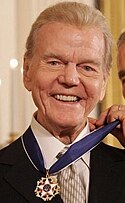"Push-and-pull" effect
Talk radio, has been described as indulging in "edgier" content than network TV conservative political programs on Fox News, etc., which have a broader audience that includes non-right-wing viewers. Radio hosts' remarks on "race, immigration and other subjects" can be more extreme, listeners who call in are more likely "to say what they really think", which gives "the shows a renegade feel and keep listeners loyal and emotionally invested". [6] But the advertisers—on which the hosts depend for their "multimillion-dollar paychecks"—can be subject to boycott campaigns when word gets out on beyond the right-wing community about what the hosts and callers have said. Consequently, the host often engage in "push-and-pull" — stoking "listeners' anger" to build ratings, but then pulling back and "disavowing the more extreme views voiced by callers" to avoid a backlash from moderate and liberal public. [6]
Prior to the January 6, 2021 storming of the United States Capitol, radio hosts were prone to making statements such as the following:
- "It is time to rip and claw and rake, It is time to go to war, as the left went to war four years ago." (Glenn Beck, January 4, 2021) [6]
- Since stealing elections "is becoming the norm for the Democrat Party", conservatives need to "crush them, crush them. We need to kick their ass."(Mark Levin) [6]
- "I will never surrender and collapse and act as if it's OK when hundreds of thousands have voted illegally." (Bill Cunningham, a syndicated host in Cincinnati, January 4) [6]
- "There's no doubt this [the 2020 presidential election] was stolen. No doubt whatsoever." (Sean Hannity, December 18, 2020):
- Joe Biden "didn't win this thing [the 2020 United States presidential election] fair and square, and we are not going to be docile like we've been in the past, and go away and wait till the next election." (Rush Limbaugh, December 16, 2020) [6]
But later in his December 16 show, Limbaugh said that he had "mixed emotions" about the January 6 march on Washington. In a December 9, 2020 show, Limbaugh declared, "I actually think that we're trending toward secession", and the next day said, "I am not advocating it [secession], have not advocated it, never have advocated it, and probably wouldn't". [6] When a caller to Sean Hannity's January 5 show referred to the Democratic governor of Michigan Gretchen Whitmer as "Governor Hitler", Hannity responded, "easy, now. When you make those references, everyone says, 'Hannity allowed someone to make a Nazi comparison!'" [6]
Rush Limbaugh–Sandra Fluke controversy
One boycott campaign was instigated during the Rush Limbaugh–Sandra Fluke controversy that spanned from February to March 2012, in which Rush Limbaugh made comments against a Georgetown University Law student, Sandra Fluke, who had been active advocating for including birth control in government-mandated health insurance even when the payer was a Catholic institution. Limbaugh called her a "slut" and "prostitute" under the logic that demanding birth control coverage was the equivalent of demanding "that she ... be paid to have sex", [7] and that in return for insurance coverage, Fluke should be required to "post the videos" of her having sex online. [8]
So, Ms. Fluke and the rest of you feminazis, here's the deal. If we are going to pay for your contraceptives, and thus pay for you to have sex, we want something for it, and I'll tell you what it is. We want you to post the videos online so we can all watch. [8]
Limbaugh continued to dwell on Fluke and her alleged sex life the next day with him saying things like if his daughter had testified that "she's having so much sex she can't pay for it and wants a new welfare program to pay for it", he would be "embarrassed" and "disconnect the phone", "go into hiding", and "hope the media didn't find me". [8] In response to Limbaugh's remarks Fluke accused him of attempting to silence her. Several online and social media campaigns were created such as a Flush Rush group [9] on Facebook and the Stop Rush database. [10] As a result, by March 3, over a dozen advertisers [11] [12] had discontinued their sponsorship. [13]
On that day, Limbaugh made a public apology on his show, stating that "... My choice of words was not the best, and in the attempt to be humorous, I created a national stir. I sincerely apologize to Ms. Fluke for the insulting word choices." Fluke replied that she didn't think his apology under boycott pressure changed anything. In response to these events, 12 sponsors withdrew their support of Limbaugh's show. [14]
- Sean Hannity and Michael Savage
Sean Hannity and Michael Savage, two nationally syndicated hosts, began a feud that began in January 2014. The conflict started when Savage decided to move the live broadcast of his show, The Savage Nation , from his original 6-9 p.m. ET timeslot (which is timed to mid-afternoon in the Pacific Time Zone; Savage originates his program from San Francisco, and it was formerly an afternoon drive show for that market) to 3–6 p.m. ET, directly challenging the New York-based Hannity on the East Coast after Cumulus Media dropped Hannity's show from their stations in major markets and picked up Savage from the Talk Radio Network to be syndicated by their Westwood One division. [15]




